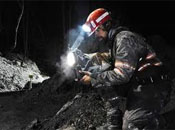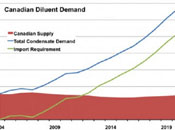A funny thing happened along the road that leads to shale plays as a major key to North American oil growth: the nomenclature.
Many emerging US fields now commonly considered part of the "shale" boom are not really shale at all, but rather tight oil such as in the Permian Basin or even conventional fields made un-conventional by modern techniques such as horizontal drilling, multistage fracturing that helps draw more oil from rocks and long lateralsthe horizontal leg of a wellto enhance their economics.
"Shale is very fine grained rock," containing silica, Peng Li, petroleum geologist at the Arkansas Geological Survey, said. According to other sources, it also contains clay and even quartz. On the other hand, other plays being developed unconventionally are carbonates (such as the Permian Basin), sandstone, siltstones, limestone or even mudstone. "The difference is in the type of rock," Li said.
While the Eagle Ford Shale in South Texas and Bakken Shale in North Dakota/Montana are two of the biggest shale oil plays, wildcatters continue trying to smoke out the next big oil find. There, shale hasn't been the draw, but rather conventional fields some of which have produced modestly for years.
Company managers are now talking up older fields such as the Woodbine in East Texas, the Brown Dense in Louisiana/Arkansas and the Tuscaloosa Marine Shale in Louisiana/Mississippi as potential up-and-comers.
-
The Woodbine consists of sandstone and siltstone rocks, located at about 7,400-9,400 foot depths across several counties north of Houston. The formation sits below the Eagle Ford horizon, which some operators say is also potentially productive in that area. For that reason, many operators call it the Eaglebine play.
But according to oil companies, the Eagle Ford zone there is shallower than in south Texas where production is galloping. Eaglebine wells have approached initial production rates of a solid 1,000 b/d of equivalent oil in some cases; small operator Crimson Exploration, for instance, has seen rates above 1,200 boe/d. The company has said other zones may also be productive.
Global Hunter Securities cited a Devon Energy well that debuted at 936 boe/d from the Georgetown formation, while tiny Navidad Resources has vertically commingled the Buda, Georgetown and Glen Rose formations and "has produced 135,000 boe in a year," or about 370 boe/d.
The Woodbine also has favorable well costs around $5.5 million versus $6-$7 million in the South Texas Eagle Ford, companies have said.
- The Brown Dense play is an old play made up of carbonate mudstone found at roughly 8,000-12,000 feet depths. Southwestern Energy, which pioneered the Fayetteville Shale, is a leader in this play also. It has drilled six wells, all but one in Louisiana.
One of the wells came in at over 1,000 boe/d of output that included 421 b/d of oil. The company is targeting sections 300-500 feet thick.
CEO Steve Mueller said in an August company call that its Brown Dense wells could cost $10-$12 million, topping initial $8 million estimates due to higher-than-expected well pressures. "When you start looking at how that works out on the economics, I think [a] 500-barrel-a-day range on the oil-only side still makes that work," Mueller said.
- The Tuscaloosa Marine Shale is a shale, found between 10,000 to more than 16,000 foot depths with thickness varying from between 500 feet in Louisiana to over 800 feet in Mississippi, according to a report released earlier this year by David Dismukes, associate executive director of the Center for Energy Studies at Louisiana State University.
Tuscaloosa operator Devon Energy so far has drilled three wells in the play; the first averaged just shy of 300 b/d and the second, 670 b/dan improvement, which company officials say they hope to sustain. Because of the depth, wells are costly at $12 million to the mid-teens. "Reducing costs and improving well performance over time are keys to making this play economic," said David Hager, Devon executive vice president of E&P.
- Then there is an apparent one-man shop in an acreage spread west of Houston called the Navarro/Midway field. Said GHS in a recent report, "nobody else is leasing here, but [Halcon Resources CEO Floyd Wilson] liked this play so much he leased it personally" after selling his former company, Petrohawk Energy, last year. Petrohawk in 2008 pioneered the Eagle Ford Shale; BHP Billiton gobbled up the company for $15 billion.
The Navarro/Midway are two formations; Halcon has targeted both in vertical wells which require multistage fracturing to make them economic, Wilson said at a recent energy conference. The company has drilled two wells there; both should unearth a mix of oil, natural gas and gas liquids, he said.
Navarro is the deeper zone that may hold more gas and less oil; Midway has "a lot more oil and a little less gas," said Wilson. "I'm expecting big numbers."
Starr Spencer
Platts























































